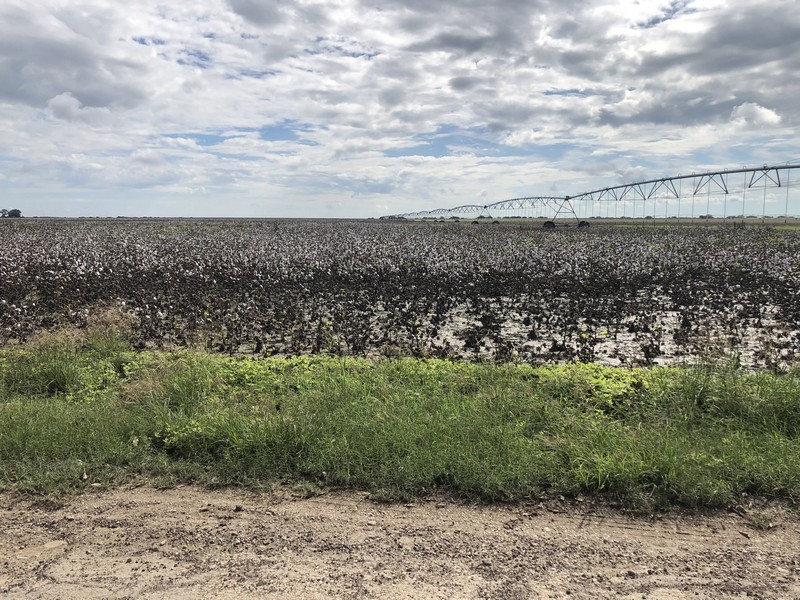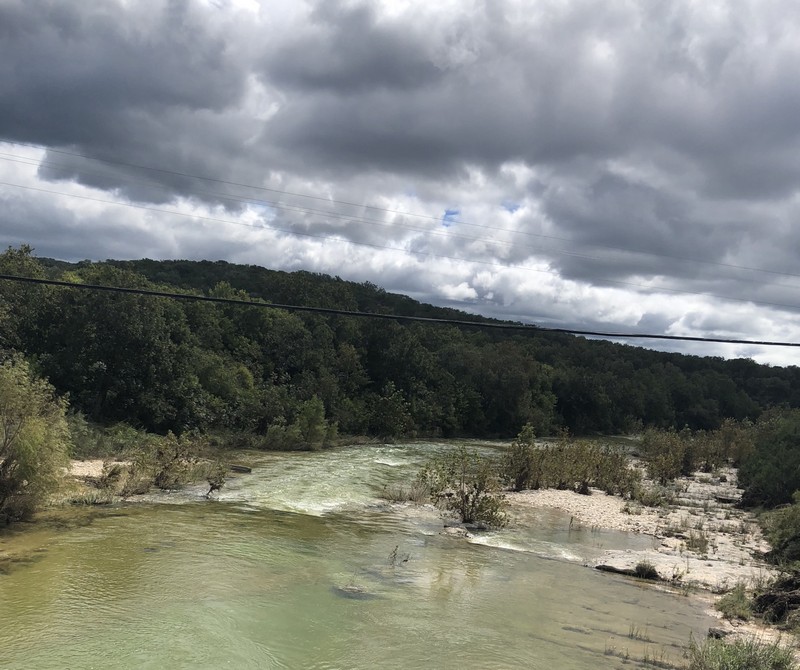
A few days following our recent record-breaking rains, a trip through Hondo, north to Tarpley, west to Utopia, further west and north to Leakey and Alto Frio, then back south through Sabinal evoked reflections of God’s grandeur and the beauty of our Texas Hill Country. The green countryside was a rare site, considering the recent drought, with cattle and deer contentedly grazing in tall, lush grasses, and the leaves of the rain-washed trees were showing just a hint of turning, heralding fall. The Frio, which disappointed thousands of tourists with a shallow, bumpy “float” this summer season, was rushing and cascading, a would-be rafter’s delight. The Hondo Creek, a tributary of the Frio River and generally shallow with a rocky, limestone bed, was running at full tilt as it criss-crossed Hwy 462 all the way from Hondo to Tarpley and above. And, as it crosses Highways 90 and 173, travelers saw it flowing deep and high.
Medina Lake, whose levels vacillate from near dry to maximum depth every few years, is enjoying a water level of 1.047.80 feet MSL, barely below a full pool of 1.062.00 as of Monday, September 24, 2018, and is rising – albeit, it does still have a ways to go to reach its capacity.
That’s the upside of the recent rains, some farmers and residents reporting over 20” in a two-week span. Subsequently, the Medina River, Quihi Creek, Burnt Boot Creek, and countless other creeks and low water crossings created numerous road closures due to high water. Then, after those two weeks, even more rains came – and are still coming. Some Medina Countyresidents reported from 4” to over 5” two Saturdays ago, then more fell this past weekend and yesterday!
As a result, many folks have suffered greatly. With those unexpected rains the morning of September 22, the Medina River RV Park in LaCoste saw its community devastated. RV residents there reported that the river rose without warning and so quickly that all they could do was watch the waters “swallow their RVs and vehicles.” (KENS 5)
And, oh, the chug holes! Some of those monsters rival sink holes! One not only pities the county commissioners with their overwhelming job of repairing thousands of miles of damaged roads, but pities also the residents who had to traverse pathways that were once roads before becoming barely navigable. When possible, as with CR 467 toward Dunlay, many residents had to choose alternate routes before the crews began their onerous jobs. And some repairs will need to be done again.

Meanwhile, countless farmers in the affected areas have had to watch their crops submerged in fields that resemble lakes. And what is the cost of this crop disaster? One area farmer, Tom Ducos, explained that once the cotton has been defoliated, as it was a few days prior to the first onslaught of rains, it is sitting out of its bowl. Then, with the rains, the seeds within the bowl began to sprout. Thus, the cotton fiber is stained, the grade quality is compromised, and the seeds are lost. Normally, when the cotton is ginned, the seeds are captured, which offsets the cost of the ginning process, as they are then used for future sales. Bottom line: no seeds, lower cotton grade, higher ginning cost.
Those first heavy rains that lasted for days were followed by a few days of intermittent semi-sunshine. Some cotton farmers then had their crops defoliated again – defoliating being a necessity when the cotton is ginned – as plants were putting on new leaves. Then, more rains came – more new leaves; even more new blooms, another round of aerial defoliating, more rains….
Other farmers were fortunate enough to have gotten their cotton harvested before the torrential rains, and their beautiful, round bales can be seen dotting the countryside. However, when the bales sit in water, the cotton seeds will sprout. Also, along the exposed sides of the bales, these kinds of rains will do some damage. The result is that there will be some loss.
Other crops also experienced stress, such as sesame and cucumbers. The sesame plants, whose stalks were standing tall and loaded with seeds, leaned over with the weight of the water. Although sunshine may cause the stalks to stand up again slightly, it still may be difficult for the machinery to capture all the seeds. Cucumbers, meanwhile, were young plants, and they are still putting out blooms and pickles. Ducos says it’s just a “wait and see” situation.
What now? Affected farmers have just been hoping for a week or so of full sunshine – and yet there have been more rains – to dry out the fields enough to get the equipment in. After that, the value of the harvest will be far less than hoped for or what it could have been before the devastating rains.
As for crop insurance, that’s a complicated program. One agent explained that Texas in going to have to pay out a tremendous amount of money this year, with droughts in West Texas and East Texas which destroyed the crops, to flooding here in our part of South Texas and along the coast.
Rollin Heifrin, of Heifrin Crop Insurance out of Hillsboro, explains that the payouts are determined by the percentage the farmers chose prior to planting. The farmer chooses the percentage based on his hopeful good harvest. Heifrin explains that the farmer is always better off to make a good crop and pay his premium, but crop insurance will help him remain in farming in a catastrophic year. It may not make him any money, but it will keep him in business.
So, just as with house insurance, when there is a loss, insurance monies never repay what one had or what he could have had if there had been no loss. Our farmers, who put so much heart and soul into their livelihood, are having a tough year.

The ranchers, meanwhile, say that the armyworms – a result of the rains and cloudy, damp, warm weather – are “eating us up,” as explained by J.D. Schmidt of Hondo. He says that when he saw the moths flying about a couple of weeks ago, he started watching the coastal. Subsequently, after having around 400 acres sprayed by air, his inspection revealed that the ground was covered. Schmidt said that they used a new product that has a residual effect, which he hopes the subsequent rains did not compromise, as he reports that the moths – which lay eggs that hatch out and become worms – are flying again. The process is 4-5 days during which time these armyworms can wipe out any grasses where there is a bad infestation. Schmidt said that the very next day, the grasses had begun to recover. And, these infestations are affecting ranchers and farmers not only in this area but in much of Texas.
Back to an optimistic view, tanks are full; cattle are fat; grass is green and growing; springs are regenerated…. Farmers will plant wheat and oats and surely save on irrigation costs. And the winter months promise to be easier on ranchers than what it could have been had the drought not been broken – at least for a season.